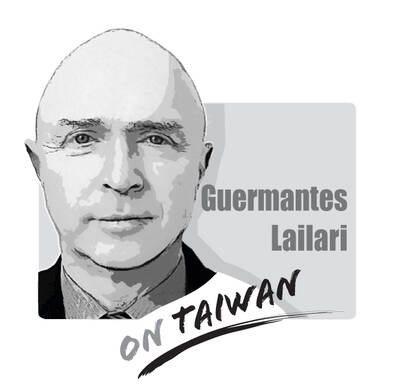On May 19, a Chinese television station displayed its so-called creative and politically correct poker card design featuring images of “Taiwan independence supporters.”
It is a pity that the company did not also design playing cards featuring the pro-unification activists preferred by Beijing, so that Chinese could also see what they look like.
The pro-independence playing cards exposed how ignorant China’s “united front” tactics are. Perhaps Beijing was trying to narrow its scope of attack by changing its target from all Taiwanese to a few individuals; making examples of the 13 A-list figures to warn others, similar to how one might put heads on spikes or “kill the chicken to frighten the monkey,” as they say in Chinese.
By doing so, it could then comfort and deceive itself that the pro-independence activists in Taiwan are but a handful of people.
The Chinese Communist Party regime is arrogant, egotistical, autocratic and reckless. It shows no respect for its own people and does not know that legitimacy of rule comes from free elections.
The 13 pro-independence playing cards are unlikely to intimidate Taiwanese. More pro-independence activists might even protest against Beijing, while blaming themselves for not working as hard as Alliance of Referendum for Taiwan convener Tsay Ting-kuei (蔡丁貴), whose image is one of those on the cards.
The 13 cards prove that Taiwan and China are two nations on the two sides of the Taiwan Strait.
Of Taiwan’s four directly elected presidents, two former presidents — Lee Teng-hui (李登輝) and Chen Shui-bian (陳水扁) — as well as President Tsai Ing-wen (蔡英文) feature on the cards.
Others include a former vice president, two former premiers and Premier William Lai (賴清德).
Since pro-independence activists were able to be elected as presidents, this shows that Taiwan is an independent, sovereign state.
The Chinese TV station is simply consoling itself at home with the pro-independence playing cards.
If China was confident, it would design playing cards featuring those who identify with the “motherland.” It might even be more fun to play with both sets of cards.
Since Beijing knows all too well which Taiwanese travel to China for personal gain and take its orders to assist in Taiwan’s demise, it would not be difficult to design a set of pro-unification playing cards.
What we can be sure of is that those featuring on the pro-unification cards would include former president Ma Ying-jeou (馬英九) of the Chinese Nationalist Party (KMT), who was elected thanks to his screaming female fans; former Bamboo Union leader Chang An-le (張安樂), also known as the “White Wolf,” who is backed by both his gang and the communists; former KMT chairwoman Hung Hsiu-chu (洪秀柱), who is willing but unable to lead the unification camp; China Times Group chairman Tsai Eng-meng (蔡衍明), who has made a fortune in China; and the descendants of the Chiang (蔣) dynasty.
Maybe KMT Chairman Wu Den-yih (吳敦義), with his trademark crew cut, could also be added to the list.
If we compare those who would likely be on the pro-unification playing cards with those on the pro-independence cards, there seems to be a huge gap between them in terms of character and reputation.
Some might feel lucky that they do not feature on the pro-unification cards, but surely no one would protest if they were not listed with people such as Wu.
James Wang is a senior journalist.
Translated by Eddy Chang
The gutting of Voice of America (VOA) and Radio Free Asia (RFA) by US President Donald Trump’s administration poses a serious threat to the global voice of freedom, particularly for those living under authoritarian regimes such as China. The US — hailed as the model of liberal democracy — has the moral responsibility to uphold the values it champions. In undermining these institutions, the US risks diminishing its “soft power,” a pivotal pillar of its global influence. VOA Tibetan and RFA Tibetan played an enormous role in promoting the strong image of the US in and outside Tibet. On VOA Tibetan,

There is much evidence that the Chinese Communist Party (CCP) is sending soldiers from the People’s Liberation Army (PLA) to support Russia’s invasion of Ukraine — and is learning lessons for a future war against Taiwan. Until now, the CCP has claimed that they have not sent PLA personnel to support Russian aggression. On 18 April, Ukrainian President Volodymyr Zelinskiy announced that the CCP is supplying war supplies such as gunpowder, artillery, and weapons subcomponents to Russia. When Zelinskiy announced on 9 April that the Ukrainian Army had captured two Chinese nationals fighting with Russians on the front line with details
On a quiet lane in Taipei’s central Daan District (大安), an otherwise unremarkable high-rise is marked by a police guard and a tawdry A4 printout from the Ministry of Foreign Affairs indicating an “embassy area.” Keen observers would see the emblem of the Holy See, one of Taiwan’s 12 so-called “diplomatic allies.” Unlike Taipei’s other embassies and quasi-consulates, no national flag flies there, nor is there a plaque indicating what country’s embassy this is. Visitors hoping to sign a condolence book for the late Pope Francis would instead have to visit the Italian Trade Office, adjacent to Taipei 101. The death of
By now, most of Taiwan has heard Taipei Mayor Chiang Wan-an’s (蔣萬安) threats to initiate a vote of no confidence against the Cabinet. His rationale is that the Democratic Progressive Party (DPP)-led government’s investigation into alleged signature forgery in the Chinese Nationalist Party’s (KMT) recall campaign constitutes “political persecution.” I sincerely hope he goes through with it. The opposition currently holds a majority in the Legislative Yuan, so the initiation of a no-confidence motion and its passage should be entirely within reach. If Chiang truly believes that the government is overreaching, abusing its power and targeting political opponents — then